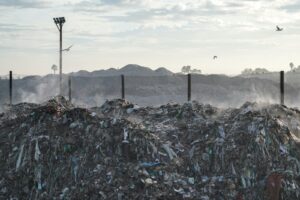Mitigating the impact of Shanghai’s rapid growth
It’s one of the world’s largest cities and can amaze and appal in equal measure. But there are signs Shanghai has environmental ambitions to match its economic goals
Shanghai. Just the name conjures up mystique and uniqueness that seems so alien from the world’s western cities. But now, as it becomes a genuine world-class city, it faces some mighty environmental challenges too.
In reality, the city is becoming ever more familiar to ‘westerners’ as recognisable brands fill shopping malls, Mercedes, Audi, Ford and Land Rover’s cars fill roads while the world’s tastes are met with a cuisine that caters for all. Everywhere you turn you’ll see Nike, Adidas, New Balance, North Face, McDonalds, KFC, Pizza Hut, M&S, Hilton, Ramada, Radisson. Perhaps the mystique is there but you just need to look a little harder to find it as global brands mask the city’s hidden gems.
It’s hardly surprising that Shanghai is fast becoming a cultural melting pot of the east and west. After all, it is the most populous city in the People’s Republic of China as well as the most populous city proper in the world with more than 24 million people. As China’s rapid urbanisation continues the city has become something of a hybrid, culturally and economically.
There is no instant ‘I’m here’ moment as you pass a city boundary announcing ‘Welcome to Shanghai’. No, the city sneaks up on you and before you know it you’re enclosed on all sides by looming skyscrapers, tower blocks and concrete structures. Along all the major transport routes into the centre you will find unbridled development for tens of miles outside the city itself – ribbons of development fluttering into the Chinese countryside and those spaces between the urban areas that are becoming smaller and smaller.
But, with size comes responsibility. When you’re a global financial centre and a transport hub with the world’s busiest container port you are inherently connected to other great cities. In the last two decades Shanghai has been one of the fastest developing cities in the world. Since 1992 it has recorded double-digit growth almost every year except during the global recession of 2008 and 2009. In 2011, Shanghai’s total GDP grew to 1.92 trillion yuan ($297bn) with GDP per capita of 82,560 yuan ($12,784).
While many European cities have developed over thousands of years and seen rapid growth since the industrial revolution, cities like Shanghai are not only seeing the fastest urbanisation but also the biggest. Pressure on land, which is mainly owned by the Chinese state governments, means cities are growing upwards while land is reclaimed from the sea with dykes, ditches, dams and bridges turning floodplain into developable land.
The first thing you notice when you arrive into Shanghai, be it by land, air or sea, is the smog. The city is choked by it. You’ll taste it when you leave the air conditioned airport. The sun barely makes it through the haze on some days as the heady cocktail of ozone, particulates, nitrous oxides and sulphur fill the air – and your lungs. You’ll feel wheezy and the taste grabs the back of your throat immediately. It’s not something you get used to either. Talk to a resident of Shanghai and they’ll tell you it’s bad and getting worse.
Air quality is acknowledged as a serious issue by the government. When you can see it and photograph it from space, as NASA has done, then you cannot pretend it’s not happening. The perception that it’s not important to the authorities in China is not true. Social media is, democratically, raising awareness of the issue in the major cities, particularly Beijing and Shanghai but in other conurbations too. In fact, speaking to residents in Shanghai, they are now more likely to check the air quality forecast as the weather forecast.
As public awareness of the environment grows so do does investment in environmental protection projects. A 10-year, $1bn clean-up of Suzhou Creek, which runs through the city-centre, takes centre stage in the Exhibition of Urban Planning where a vibrant liveability agenda is promoted and shared for discussion and consultation with visitors paying 30RMB (approx. £3) to see the history and future of Shanghai laid out before them.

A model of central Shanghai at the Exhibition of Urban Planning
Here, the Shanghai government sets out an attractive sustainability vision that addresses the environmental, social and economic aspirations you would expect of any city. What sets it apart is it actually appears to be doing it. For example, transportation companies are given incentives to invest in LPG buses and taxis. To address the industrial pollution, the government has moved almost all factories within the city centre to the outskirts or other provinces.
Some consider air pollution in Shanghai to be low compared to other Chinese cities, but it is still substantial by world standards. During the December 2013 eastern China smog, air pollution rates reached between 23 and 31 times the international standard. As a result, the Shanghai Municipal Education Commission received orders to suspend students’ outdoor activities. Authorities pulled nearly one-third of government vehicles from the roads, while a mass of construction work was halted. Most of inbound flights were cancelled, and more than 50 flights were diverted at Pudong International Airport.
These actions would not have been taken lightly. The economic impact of air pollution is acknowledged and the government will need to take a more strategic approach to improving air quality if it is to avoid further spikes of this magnitude.
Like most countries and cities, traffic emissions are unregulated and uncontrolled. Car growth in Shanghai has been rapid as wealth increases and car ownership has become affordable not just for the super-rich but for the expanding middle classes too.
It’s not just traffic that’s contributing to the pollution. Travel along the highway or major rail lines at night and you will see fires lit across the fields burning off crop residues like we used to see in the UK 20 or 30 years ago. Localised plumes of black smoke blowing downwind into towns and villages. China’s urban growth and expansion is seeing huge amounts of construction underway with the resultant dusts. What compounds the issue is the relative lack of regulation, standards and adoption of good practice on construction sites across China. This has led to localised incidents of poor air quality as millions of tonnes of concrete are poured on a daily basis.
Perhaps the most significant contributor continues to be emissions from coal fired power stations. Of all the fuel choices coal is dirtiest and, while China is investing in renewables, it relies on its significant reserves to power unprecedented demands for power as the country not so much transitions – more leaps – into a technological age of rapid people and data movement.
The Shanghai response is to create a vision of green spaces, high quality mass-transit public transport, low emission vehicles and renewable energy technologies. Visit the Exhibition of Urban Planning and you can’t help feel that this is a city that is serious about tackling the issue. Here you will see analysis of the growth of the city, the investment made in the metro network and modal shift from car to tube train.
The vision is to create four centres – the international economic centre, the international financial centre, the international shipping centre and the international trade centre. By 2020 it will be a ‘global city’ and ‘international metropolis of socialist modernisation’ that aims to align economic, social and ecological benefits.
Will it be delivered? China has the world’s fastest train in the Maglev with a top speed of 431 km/h (268 mph) exiting the Shanghai Pudong International Airport. It runs on the 30.5km Shanghai Maglev Line, the first commercially operated high-speed magnetic levitation line. The journey itself takes little more than eight minutes and is busy throughout the day – I witnessed it incredibly busy on a Sunday morning in April.
Shanghai’s extensive public transport system, largely based on metros, buses and taxis provides affordable, frequent and fast intra-city travel. The metro incorporates both subway and light railway lines and extends to every core urban district as well as neighbouring suburban districts. It is the world’s largest rapid transit system by route length and second largest by number of stations, with 14 lines and 364 stations totalling 365 miles. It also ranks second in the world by annual use after Beijing, with more than three billion rides in 2015.
Shanghai still conjures up mystique and intrigue that will continue to attract trade, tourism and technology to the city on the East China Sea. But its rapid growth have led to significant environmental challenges of which air pollution is, perhaps, the most recognised and visible. Where cities elsewhere in the world fail to respond to this challenge, it is encouraging that Shanghai is willing to take radical steps in emergency situations but also to plan for a brighter, greener, cleaner future. The investments already made in light, rapid transport are leading to millions of passengers every day electing to use the metro alone.
But still the roads are clogged, coal power stations are burning and the construction sites active. As long as the air is full of smog the environmental challenge is clear. In the absence of EU-style directives and legislation it is likely to be the rising democratic challenge and the cost to the economy that will see the most substantial of infrastructure investments made to address it. Shanghai: the name should always be one of wonder, not of trouble.












